
Best For
- Exceptional pressure relief with 13″ thick profile
- Low levels of motion transfer with deep contour and hug
- Sleepers who have already slept on and love Tempurpedic mattresses
Considerations
- 189% more expensive than the average memory foam mattress
- Ranks in the bottom 12% of all mattresses tested to date due to cooling, response, sex, off-gassing, and company issues
- Poor cooling performance with high levels of heat retention
Our Verdict
The Tempurpedic Pro Adapt mattress is a 13″ memory foam mattress that contains traditional memory foam, transitional poly foam, and a support foam base.
This mattress has minimal sinkage and very low levels of bounce. It offers a classic memory foam feel with slower material response time and deep levels of contour.
The Pro Adapt comes in three firmness levels—medium (5), medium-firm (6), and slightly firm (7). It is also offered in a medium hybrid version, which has a medium-firm feel.
In our performance tests, the Pro Adapt has an overall score of 7.87, ranking in the bottom 41% of all memory foam mattresses and the bottom 14% if we look at all 270+ mattresses we’ve tested to date.
In addition, the price is also significantly higher than the average mattress. The Pro Adapt costs $3399, 189% more than average (for reference, the average memory foam mattress is $1,178).
Given Tempurpedic’s above average price and score that is well below average, this is a hard mattress to recommend to anyone. On the positive side, pressure relief is truly outstanding and motion transfer is low. Even so, those two factors simply don’t outweigh the cooling, responsiveness, sex, off-gassing, and company issues, in my view.
Type: Memory Foam
Firmness: Medium (5), Medium-Firm (6), and Slightly Firm (7)
Best For: All Sleeping Positions, All Body Weights
In This Review
Performance Tests | Firmness | Support & Sleeping Positions | Design | Materials | Comparisons | FAQs
Performance Tests
At NapLab, we put each mattress to the test.
We test 10 different factors that impact the performance, comfort, and feel of the mattress. We then take the results of that test and compare to every mattress we’ve tested to date.
Check out the full performance table below to see how this mattress ranks:
| Factor | Tempurpedic Pro Adapt | Average |
|---|---|---|
| Overall Score | 7.87 | 8.55 |
| Price (Queen) | $3,399 | $1,178 (Memory Foam only) |
| Cooling – Score | 7.0 | 8.6 |
| Sinkage – Depth | 1.73″ | 2.15″ |
| Sinkage – Feel | Minimal | Moderate |
| Motion Transfer – Score | 9.5 | 8.2 |
| Motion Transfer – Acceleration | 6.13 m/s² | 8.78 m/s² |
| Response Time – Score | 5.0 | 8.9 |
| Response Time – Mostly Recovered | 2.5 sec. | 0.4 sec. |
| Response Time – Fully Recovered | 5.5 sec. | 1.0 sec. |
| Bounce – Height | 4.56″ | 9.45″ |
| Bounce – Feel | Very Low | Moderate |
| Edge Support – Score | 8.4 | 8.6 |
| Edge Support – Sitting | 3.25″ | 4.06″ |
| Edge Support – Lying | Fair | Good |
| Sex – Score | 6.7 | 8.4 |
| Pressure Relief – Score | 10 | 8.7 |
| Comfort Layer Thickness | 3.5″ | 4.1″ |
| Mattress Thickness | 12″ | 12.0″ |
| Off-Gassing – Score | 7.8 | 8.2 |
| Off-Gassing – Smell | Strong | Strong |
| Off-Gassing – Days | 8 days | 6 days |
| Company – Score | 6.4 | 8.8 |
| Trial | 90 nights | 176 nights |
| Warranty | 10 years | 25% have lifetime warranties, average of other 75% of mattresses is 13 years |
How is Tempurpedic Pro Adapt Different?
The Tempurpedic Pro Adapt is a memory foam mattress with a below-average performance score as well as an above-average price tag. If you’re looking for a great value, the Pro Adapt isn’t it. This mattress is 2.8X the cost of the average memory foam mattress, costing an additional $2,221 for a queen mattress.
Advantages
Performance advantages of the Pro Adapt include lower levels of motion transfer and exceptional pressure relief. These are areas where memory foam historically shines and if these factors are critically important, maybe it’s enough to carry the mattress for you.
Neutral Factors
The Pro Adapt has minimal sinkage and very low levels of bounce. These two factors are considered “neutral” as different sleepers will likely have different preferences in this area.
Disadvantages
Disadvantages of the Pro Adapt are numerous and include fair cooling, slow material response, and struggling edge support (especially when lying down).
The sex score is also well below average, but that isn’t too surprising given the properties of traditional memory foam and the low bounce levels. Lastly, this mattress off-gasses slower than average.
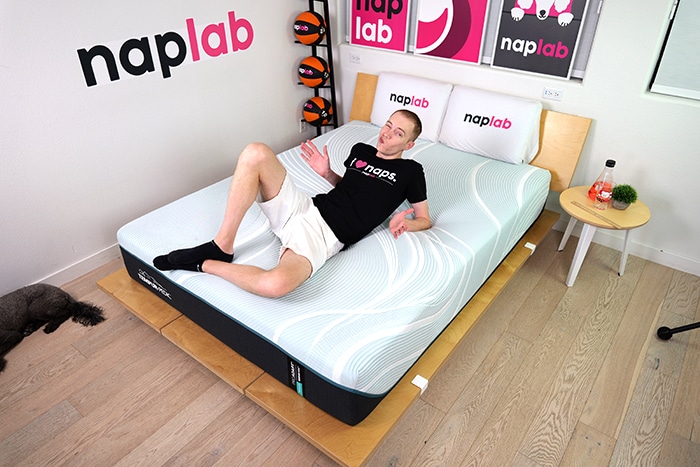
The trial period is shorter than average (only 90 nights) and returns cost a fee of $175. Overall, the disadvantages far outweigh the advantages of this Tempurpedic mattress for many sleepers, in my view.
Cooling Test
The Tempurpedic Pro Adapt has fair cooling. During our tests, I felt a moderate level of heat retention around my body.
Baseline Temp.
78.6° F
Max Temp.
91.5° F
Ending Temp.
84.3° F
I wouldn’t describe the temperature on the mattress as “hot”, but it certainly was “warm” and more sensitive sleepers could find that warming sensation more significant.
According to Tempurpedic, the mattress uses a “cool-to-the-touch” cover. However, I did not feel any notable level of cooling on the cover nor would I describe it as having a cool-to-the-touch feel.
Max Temp.
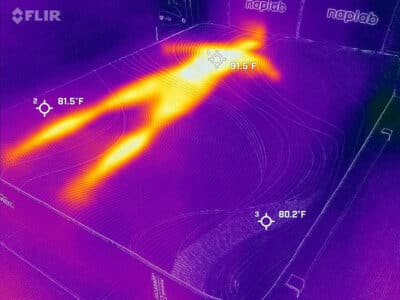
Ending Temp
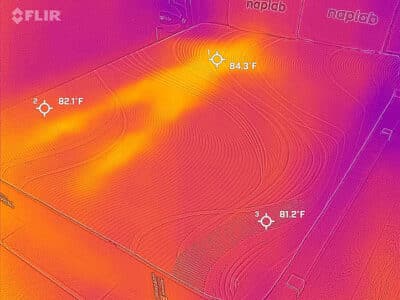
- Baseline Temperature – the temperature of the mattress before anyone lies on it
- Maximum Temperature (0 minute) – the temperature of the mattress after lying on it for 15 minutes
- Ending Temperature (5 minute) – the temperature of the mattress after being lied upon and having no one on it for 5 minutes
In our objective temperature tests, we measured a max surface level temperature of 91.5° F. This is 1.8° more than the average of 89.7° F, based on all of our tests to date.
After getting off the temperature the temperature declined by 3.8 degrees from minutes 0 to 1, which is 0.9 degrees warmer than the average 0 to 1 minute decline of 4.7°. The 0 to 5-minute temperature decline measured 5.1°, which is 2.6° warmer than the average 0 to 5-minute decline of 7.7°.
Heat Dissipation Over Time

Certainly, this combination of higher than average max temperature and worse than average heat dissipation curve is not ideal.
Often we see a heat dissipation curve being better than average in cases where the max temp is also warmer than average, as there are simply more degrees the the temperature can decline from.
However, we didn’t see that here and it’s a significant concern that it was missing. When we consider the combination of objective data, my subjective experiences, and an analysis of the materials, I’m confident in my view that cooling is fair.
Sinkage Test
The Tempurpedic Pro Adapt has minimal sinkage. During our tests, we measured a pressure point sinkage depth of 1.73″. This is 0.42″ less sinkage than the average sinkage depth of 2.15″, based on all of our tests to date.
Sinkage Depth
1.73″
Sinkage Feel
Minimal
Body Contour
Dramatic
The level of sinkage is documented in the image below.
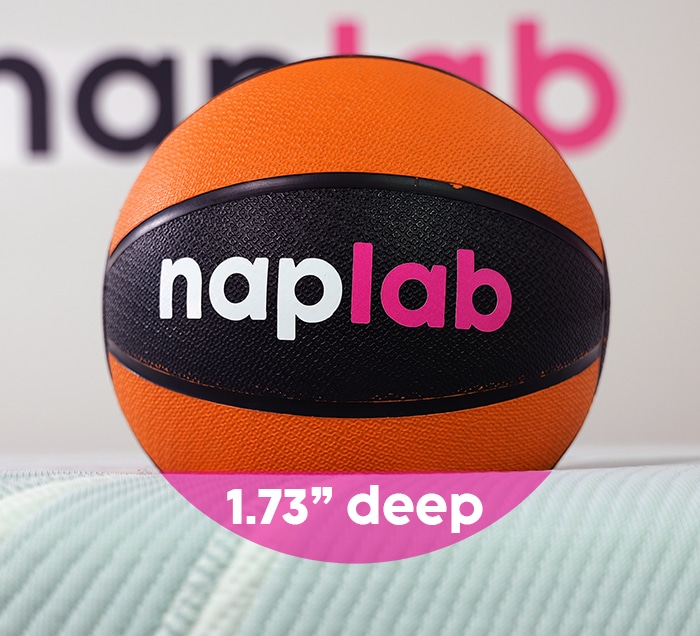
The mattress creates a more dramatic and exacting body contouring hug and the foams will contour to the exact shape of your body. Tempurpedic uses a more traditional memory foam and it’s equipped with a more classic memory foam feel.
Heavier parts of the body will sink modestly deeper into the foams, while lighter parts of the body, especially the feet, lower legs, and head won’t sink as deeply. To be comfortable with the sinkage, hug, and body contouring of the Tempurpedic Pro Adapt you’ll really need to love the feel of traditional memory foam.
Motion Transfer Test
The Tempurpedic Pro Adapt has a very low level of motion transfer. During our tests, we measured a total acceleration range of 6.13 m/s². This is 30% less motion transfer than the average of 8.77 m/s².
Accel. Range
6.13 m/s²
Motion Duration
0.56 seconds
The mattress uses an all-foam design, 3.5” of memory foam, a memory foam that doesn’t respond fast, and has a low level of bounce on the mattress at large. This combination works together to great effect to reduce motion transfer.
More traditional memory foam mattresses like Tempurpedic are among the best on the market when it comes to reducing motion transfer.
The level of motion transfer is also documented in the video below.
In our motion transfer chart, which visualizes our accelerometer data, we can see the highest motion peaks from 0 to 0.14 seconds. After which, motion declines modestly until 0.56 seconds when we reach near-zero levels.
Motion Transfer Over Time
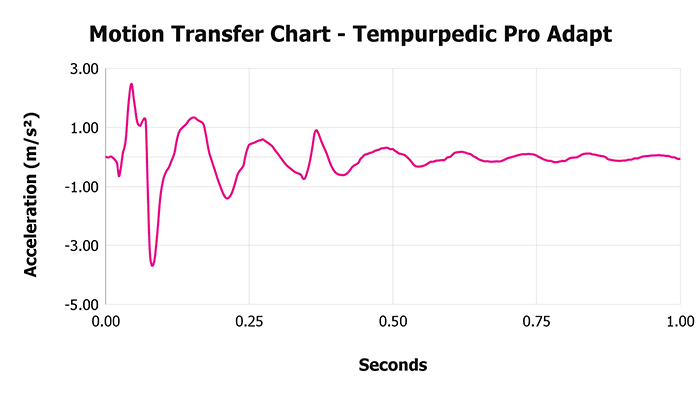
While the motion duration is longer than we’d ideally like to see, when we consider the below-average motion intensity, it’s hard to complain. Overall, I’m pleased with the level of motion transfer and don’t expect it will be an issue for most sleepers.
Response Test
The Tempurpedic Pro Adapt has a very slow material response. In our mostly recovered test, we measured a recovery speed of 2.5 seconds, which is 2.08 seconds slower than the average of 0.42 seconds, based on all of our tests to date.
Mostly Recovered
2.5 sec.
Complete Recovery
5.5 sec.
In our fully recovered responsiveness test, we measured a recovery speed of 5.5 seconds, which is 4.55 seconds slower than the average of 0.95 seconds. This mattress is the very definition of classic or traditional memory foam.
The level of responsiveness is documented in the video below.
After lying on the mattress it takes several seconds to conform to your body’s shape. Then, if you change positions or get out of bed, it will take several seconds to reform.
This is among the slowest material responsiveness speeds we’ve tested to date. That slow response speed makes it difficult to move around the mattress.
In a similar manner, it will also make sex more difficult, as your amorous energy will simply be absorbed into the mattress. The dramatic body contouring for many sleepers will create what many describe as “craters”.
Essentially, it’s the body impression due to memory foam. When combined with slower material responsiveness it can make it incredibly difficult to change positions and get out of bed.
Bounce Test
The Tempurpedic Pro Adapt has a very low level of bounce. During our tests, we measured a total bounce height of 4.56″. This is 4.89″ less bounce than the average of 9.45″, based on all of our tests to date.
Max. Depth
3.13″
Max. Rebound
1.43″
Total Bounce
4.56″
The all-foam design, thick 3.5” comfort layer of memory foam, usage of traditional memory foam, and its resultant slow material responsiveness are all contributing to the lower bounce.
Max. Sinkage Depth
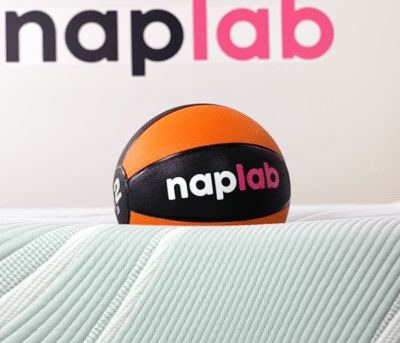
Max Bounce Height
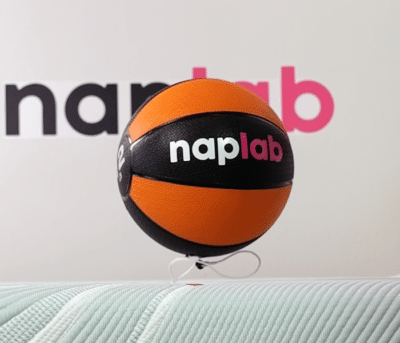
The level of bounce is also documented in the video below.
Ideally, we want to see 8-12” of bounce. Bounce within this range is enough to facilitate ease of movement and improve sex performance. Needless to say, the Pro Adapt is massively short of our ideal range.
The more limited bounce makes it more difficult to move around on the mattress and significantly negatively impacts sex performance.
While the low bounce also helps to keep motion transfer low, in my view, bounce at this level does more harm than good in terms of total performance.
Edge Support Test
The Tempurpedic Pro Adapt has excellent sitting edge support and fair lying edge support. In our sitting edge support test, we measured a sitting sinkage compression of 3.25″. This is 0.81″ less sitting sinkage than the average of 4.06″, based on all of our tests to date.
Max. Sinkage
3.25″
Lying Support
Fair
Reinforced Edge
No
While sitting on the edge, I felt well-supported. The mattress created plenty of support and there was no collapse of materials. While sitting edge support was excellent, lying edge support left something to be desired.
The level of edge support while seated is documented in the images below.
Sitting, 140 lbs.

Sitting, 200 lbs.
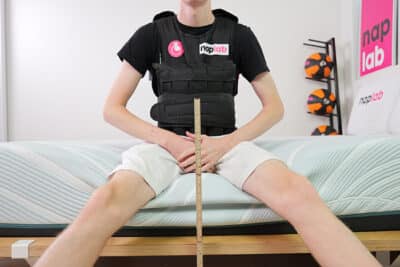
While lying directly on the edge of the mattress I did not feel tremendously well supported. Tempurpedic has the same basic problem that most memory foam mattresses have when it comes to weaker edge support.
The level of edge support while lying is documented in the images below.
Lying on Edge, 140 lbs.

Lying on Edge, 200 lbs.
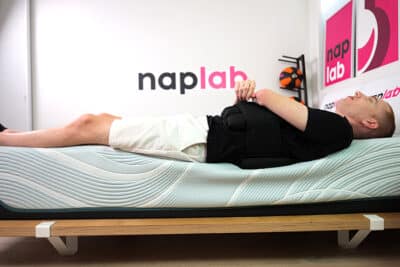
The memory foam body contouring hug, which is great when you’re more toward the middle of the mattress, creates a weakening of the support while at the edge.
This is simply because there isn’t enough foam on the edge side of the body to fully contour and hug, while also creating sufficient support. As a result, many sleepers will want to lie a few inches away from the absolute edge in order to feel fully supported.
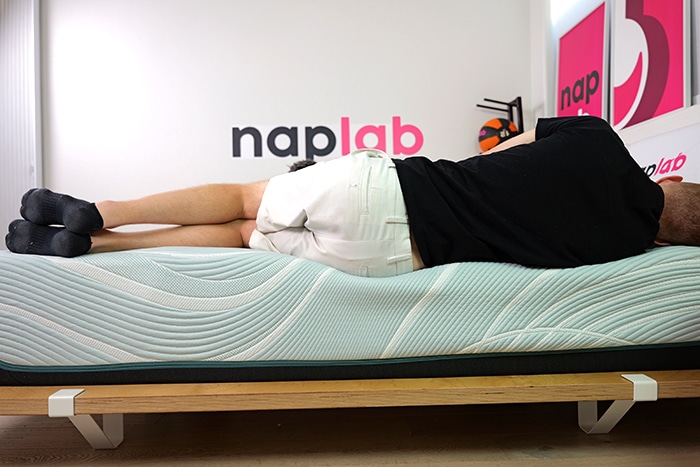
The all-foam versions of the Pro Adapt don’t have any type of reinforced edge support and it really shows while lying on the mattress. However, according to Tempurpedic, the medium hybrid version of the Pro Adapt does have “additional edge support”.
Tempurpedic doesn’t elaborate on what that means exactly, but I would guess that means they are using a pocketed coil unit that has two rows of reinforced coils along the perimeter of the mattress in the medium hybrid version. That is the typical industry standard when it comes to coil units with edge support.
Sex Test
The Tempurpedic Pro Adapt has mediocre sex performance. On the positive side, noise is minimal, pressure relief is outstanding, and edge support is excellent. In our edge support tests, we measured 3.25” of sitting sinkage.
| Sex Factor | Factor Weight | Score | Rating |
|---|---|---|---|
| Bounce | 65% | 5.3 | Very Low |
| Edge Support | 20% | 9.7 | Excellent |
| Noise | 5% | 10 | Minimal |
| Pressure Relief | 5% | 10 | Outstanding |
| Cooling | 5% | 7.0 | Fair |
This is much better than the average of 4.06”. On the negative side, we have only a fair level of cooling performance and a very low level of bounce. The Pro Adapt measured at just 4.56” of total bounce height.
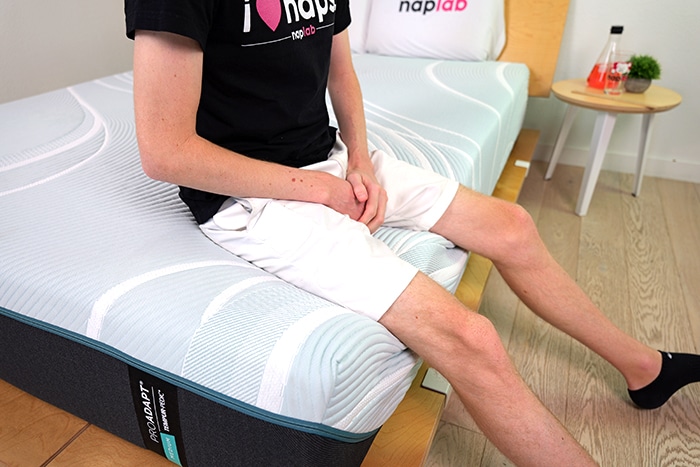
This is massively less than the average of 9.45”, based on all of our tests to date. When it comes to amorous activity performance, more bounce is always better than less.
At 4.56” of bounce the Tempurpedic is well short of what we consider enough bounce. As a result, the sex performance greatly suffers. Based on our tests, data, and analysis, I’m confident in my view that sex performance is mediocre.
Pressure Relief Test
The Tempurpedic Pro Adapt has an outstanding level of pressure relief. During our tests, I felt no pressure points anywhere on my body. Overall, I found the mattress incredibly comfortable throughout our battery of tests.
Comfort Layer
3.5″
Support Layer
8.5″
The mattress is equipped with 3.5″ of comfort material, which is 0.58″ less comfort material than the average comfort layer thickness of 4.08″, based on all of our tests to date.
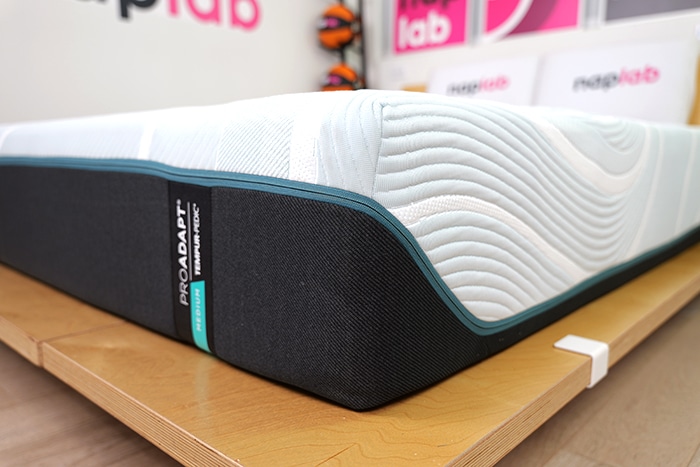
Despite having slightly less comfort material than average, this fact didn’t seem to impact pressure relief performance. Both memory foam comfort layers look and feel high quality.
And they appear to have a high foam density, based on the weight and feel (Tempurpedic does not disclose PCF density). In our objective pressure maps, we measured a max PSI of 0.95. A PSI of 2.0 is considered a “high” pressure point.
Suffice it to say, Tempurpedic is nowhere near those levels.
All 3 sleeping positions that we tested recorded extremely low levels of pressure and there were no notable pressure “hot spots” anywhere. My only concern with pressure relief is more to do with the polarizing feel of Tempurpedic’s traditional memory foam.
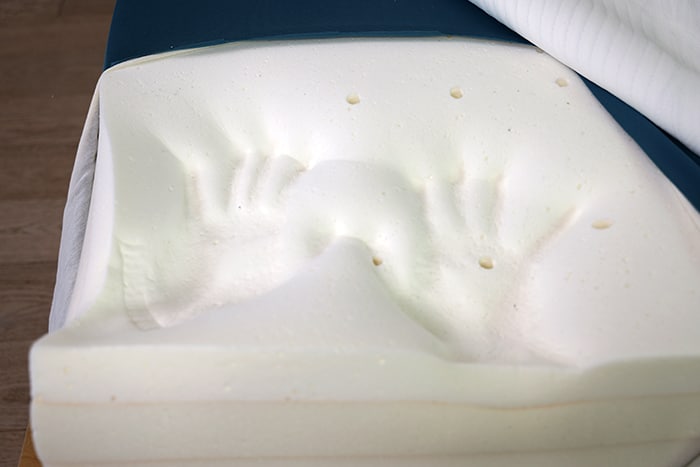
The Pro Adapt creates a dramatic body contouring hug and has a very slow material responsiveness. This makes it more difficult to move around on the mattress and change positions.
To be comfortable with the Pro Adapt you’ll need to absolutely love the feel of Tempurpedic’s classic memory foam.
All that said, when I consider the objective pressure maps, material thickness, material quality, and my subjective experience on the mattress, I’m confident most sleepers who like the feel of memory foam will find the pressure relief to be outstanding.
Pressure Map – Side Sleepers
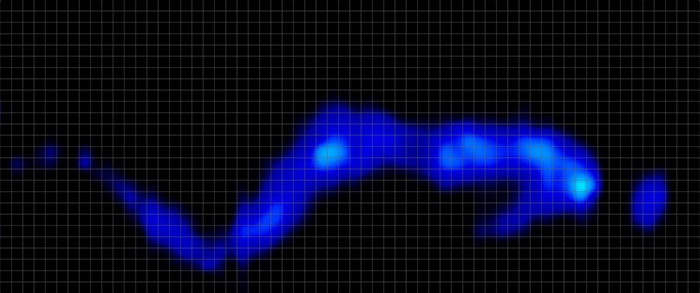
| Pressure Relief (PSI) | Average | Maximum |
|---|---|---|
| Side Sleepers | 0.17 | 0.95 |
Pressure Map – Back Sleepers
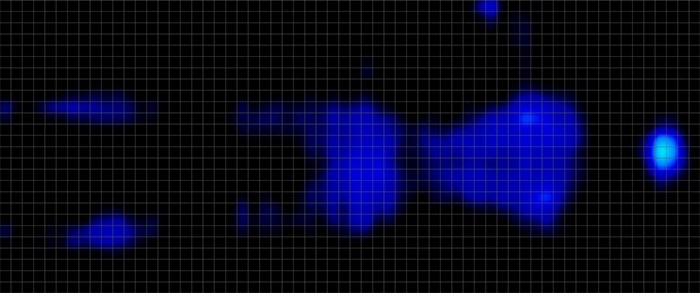
| Pressure Relief (PSI) | Average | Maximum |
|---|---|---|
| Back Sleepers | 0.11 | 0.93 |
Pressure Map – Stomach Sleepers

| Pressure Relief (PSI) | Average | Maximum |
|---|---|---|
| Stomach Sleepers | 0.11 | 0.87 |
Off-Gassing Test
The Tempurpedic Pro Adapt had a strong smell upon the initial arrival. The mattress smelled for 8 days. This is 1.6 days more than the average of 6.4 days.
Initial Smell Strength
Strong
Off-Gassing Period
8 days
We ordered our mattress from Tempurpedic.com. It arrived uncompressed, bagged, and with a full-service delivery setup.
The mattress has a fairly typical memory foam smell and its smell duration, while slightly longer than average, is nothing I find overly concerning.
Company
Tempurpedic has been around for over 30 years and is known for high-end luxury memory foam mattresses. However, many parts of its company policies were lacking when compared to many other mattress brands.
| Company Factor | Factor Weight | Score | Data |
|---|---|---|---|
| Returns | 40% | 5.0 | $175 |
| Trial Period | 30% | 6.0 | 90 nights |
| Warranty | 20% | 8.0 | 10 years |
| Shipping | 10% | 10 | $0 |
| Country of Origin | 0% | USA |
The brand offers a 90-night trial period and a 10-year warranty. Shipping is free, but if you don’t love the mattress, it’ll cost you $175 to return the mattress.
Return fees are fairly uncommon, with only 18% of mattresses we’ve tested charging a return fee. Of those brands that do charge a return fee Tempurpedic is tied for the most expensive at $175.
How firm is Tempurpedic Pro Adapt?
The Tempurpedic Pro Adapt is available in three firmness levels—soft, medium, and firm. We tested the medium version, which we found to have a firmness of 6 out of 10, where 10 is the most firm.
Medium Version
This medium-firm is available as an all-foam mattress (which we tested) and also as a hybrid, the Tempurpeid Pro Adapt Hybrid.

Soft Version
Based on material feel, quality, and other factors, we estimate the soft version to have a firmness of 5 out of 10, closer to a medium feel than a true soft.

Firm Version
And we’d estimate the firm to be around 7 out 10, with a slightly firm feel.

Support & Sleeping Positions
Support on the Tempurpedic Pro Adapt is excellent. During our tests, I felt well-supported in all sleeping positions.
| Support Factor | Data |
|---|---|
| Comfort Layer | 3.5″ |
| Support Layer | 8.5″ |
| Firmness | Medium, Medium-Firm, and Slightly Firm |
| Body Contour | Dramatic |
| Zoned Support | Yes |
| Reinforced Edge | No |
The mattress is equipped with an 8.5″ support layer. This is 0.62″ thicker than the average support layer thickness of 7.88″, based on all of our tests to date. Equally importantly, the mattress also has a 3.5″ comfort layer.
For a mattress to be supportive, it must be capable of creating sufficient comfort so sleepers can lie in the same position, while also achieving a neutral spinal alignment for sleepers.

The 12.0″ total height on the Tempurpedic Pro Adapt is able to create ample support for most sleepers. All that said, the most critical factor in whether or not you’ll feel well-supported is if you like the feel of memory foam.
Memory foam, especially more traditional memory foam like Tempurpedic uses, has a more polarizing feel. Some love it and others not so much. The body contouring hug and slower response will create significant impressions around the body (some sleepers call these “craters”).
This type of a feel is neither good nor bad, but it is a more specific feel. You’ll want to be certain you like the feel of memory foam in order to feel well-supported by the mattress.

Based on all of my tests to date, an analysis of the materials, and my subjective experiences, I’m confident most sleepers who like the feel of traditional memory foam will find support on the Tempurpedic Pro Adapt is excellent.
Check out the table below to see the sleeper weights and sleeping positions that would be best suited for this mattress.
| Sleeper Weight | Stomach Sleepers | Side Sleepers | Back Sleepers |
|---|---|---|---|
| Under 150 lbs. | Yes | Yes | Yes |
| 150-250 lbs. | Yes | Yes | Yes |
| 250-300 lbs. | Yes | Yes | Yes |
Design
The Tempurpedic Pro Adapt is a 12″ memory foam mattress that is available in three firmness levels—medium (5), medium-firm (6), and slightly firm (7).
| Design Factor | Data |
|---|---|
| Type | Memory Foam |
| Thickness | 12″ |
| Cover Type | Thin |
| Weight | 97 lbs. |
| Has Handles | No |
| Fiberglass-Free | No |
| Ships in a Box | No |
Within the Tempurpedic collection, the Pro Adapt is a part of the Adapt collection. The most budget-friendly collection is the Tempurpedic Cloud and the Adapt lineup is one step up in quality and price.
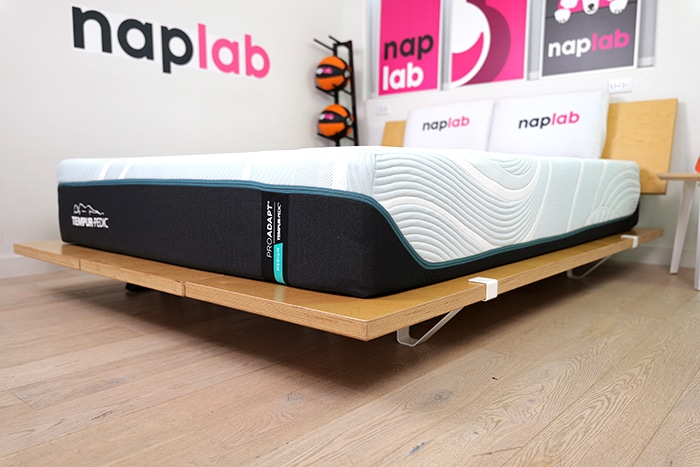
Within the Adapt collection, there is the Adapt (11″), Pro Adapt (12″), and Luxe Adapt (13″). The thicker profile of the Pro Adapt helps to provide better pressure relief and more comfort material compared to the standard Tempurpedic Adapt.
Materials
The Pro Adapt is a 100% all-foam mattress (unless you get the Medium Hybrid version, which uses support coils). There are four main layers that make up the total thickness. From top to bottom, the layers include:
| Layer Type | Thickness | Layer Specs |
|---|---|---|
| Memory Foam | 1.5″ | Not Available |
| Memory Foam | 2.0″ | Not Available |
| Support Foam | 3.0″ | Not Available |
| Support Foam | 5.5″ | Not Available |

The Law Tag outlines the full breakdown of materials included in this mattress.
- Materials
- 58% Visco Elastic Polyurethane Foam Pad
- 42% Polyurethane Foam Pad
- Cover
- Top
- 58.2% Polyester
- 41.3% Polyethylene
- 2.5% Spandex
- Side
- 99% Polyester
- 1% Spandex
- Bottom
- 52% Polyester
- 48% Cotton
- Netting
- 43.9% FR Rayon
- 37.3% Silica
- 18.8% Polyester
- Top
- Manufactured by: Tempur Production USA, LLC 12907 Comfort Way Albuquerque, NM 87120
- Made For: Tempur-Pedic Management LLC 1000 Tempur Way, Lexington, KY 40511
- Made In: Assembled In USA from Domestic and Imported Components
- Date of delivery: LEFT BLANK
- Finished Size: 80 x 60 x 12 IN.
- Net Weight of Filling Mat: 85 LBS.
- Date of manufacture: L4 01/02/2024 9:03:53
- Model: ProAdapt 2.0 Medium FLR Queen
- Prototype ID: K3A1-091123
The Cover
The cover of the Tempurpedic Pro Adapt is both thin and removable. Notably, it’s the same as the cover used on the Tempurpedic Luxe Adapt. You can wash it in a standard washing machine for a cleaner sleeping surface.
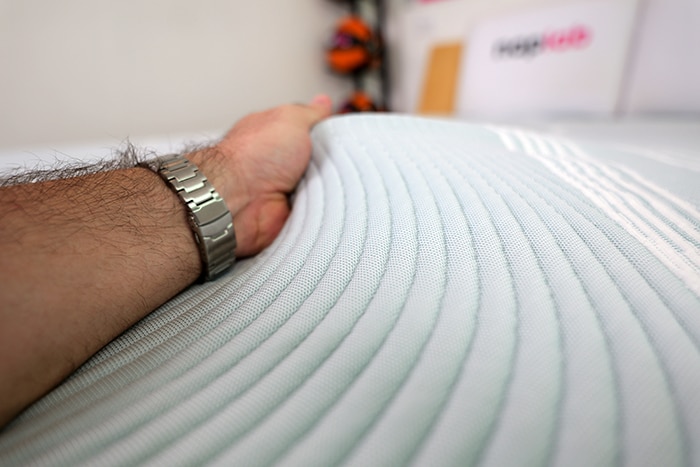
If you downgrade to the standard Tempurpedic Adapt the cover is not removable.
The Comfort Layer
The comfort layer includes a 1.5” memory foam layer followed by a 2.0” memory foam layer.
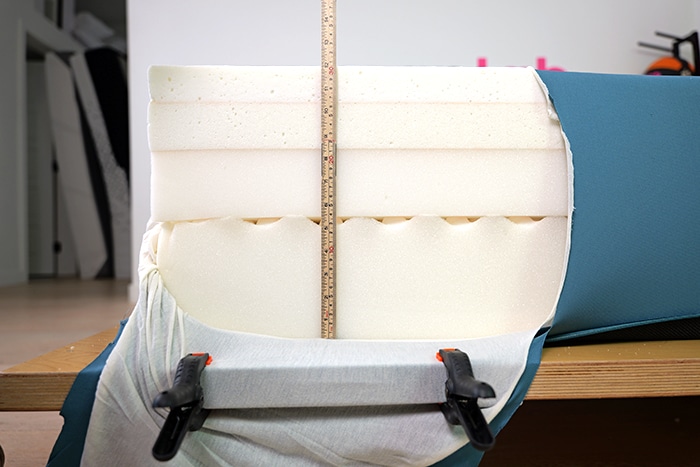
The Support Layer
The third foam is a traditional layer that feels like somewhat of a mix between a poly foam and support foam. It is designed to ease sleeper weight between the comfort layer and support layer.
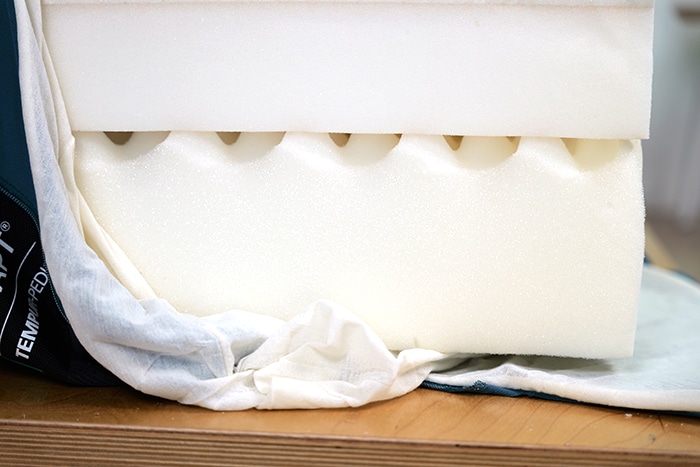
At the base, we have a 5.5″ high-density support foam. This layer is designed entirely for support for the materials above as well as total bodyweight.
Product Evolution
The Tempurpedic Adapt collection was released in 2018 with an original listing price of $2799 for a queen Pro Adapt mattress. Since its release, prices have increased up to $3399 for the same size mattress.
There have been no notable changes made to the mattress design / materials, comparing earlier versions to the present-day listing.
Other Mattresses to Consider
Not sure if the Tempurpedic Pro Adapt is the right pick for you? Check out these three other top-rated memory foam mattresses for alternatives you may want to consider.
For Performance
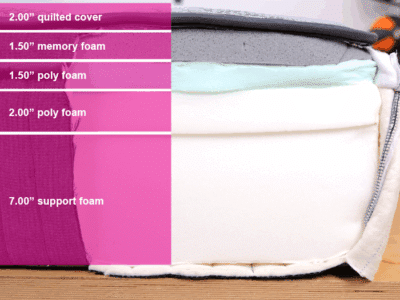
GhostBed Luxe
Thick Comfort Layer
The GhostBed Luxe is a 13″ memory foam mattress with a medium-firm feel. It has extremely deep sinkage and moderate levels of bounce. The Luxe is our highest-rated memory foam mattress tested to date and outperforms the Pro Adapt in 7 out of 8 performance categories.
For Value

Amerisleep AS3
Top-Tier Pressure Relief
The Amerisleep AS3 is a 12″ memory foam mattress with moderate sinkage and low levels of bounce. A queen mattress is only $1,299, $2,100 less than the Tempurpedic Pro Adapt. If you’re looking for savings, the AS3 is a great option. For a softer feel, check out the Amerisleep AS5.
For Cooling
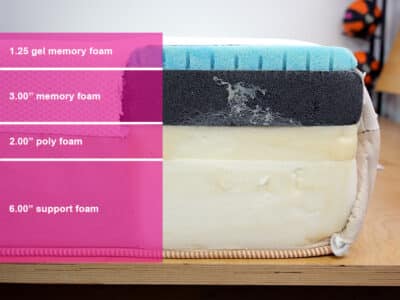
Saatva Contour5
Robust Edge Support
The Saatva Contour5 is a 12.25″ memory foam mattress with a gel memory foam top layer and fantastic cooling. This mattress has minimal sinkage with very low levels of bounce. In our tests, the Contour5 had great cooling performance, among other factors. A queen mattress is $2,695, which is more than average, but still significantly less than the Tempurpedic Pro Adapt.
Frequently Asked Questions
Still have questions? Check out some of the top FAQs on the Tempurpedic Pro Adapt mattress below and get the answers you’re looking for.
Here are the current prices, with any sales or promotions reflected below:
Twin: $2,899
Twin XL: $2,899
Full: $3,249
Queen: $3,399
King: $4,099
Cal. King: $4,099
*Note: Sales prices are subject to change without notice or warning.



